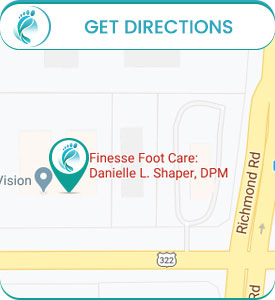Sprained Ankle Treatment Specialist in Lyndhurst, OH
Overstretching or tearing of the ankle joint’s ligaments can result in a sprained ankle. To promote tissue healing, the damaged ankle must be rested. To lessen discomfort and swelling, apply ice to the affected area. A brace or bandage applied compressively can offer stability and support. Visit Dr. Danielle L. Shaper, DPM, and her team for a full recovery and to prevent other injuries. For more information, contact us or schedule an appointment online. We are conveniently located at 5035 Mayfield Rd, Lyndhurst, OH 44124.


Table of Contents:
What is a sprained ankle?
What are the symptoms of a sprained ankle?
How is a sprained ankle treated?
How long should it take to heal a sprained ankle?
A sprained ankle is a common musculoskeletal injury which involves the overstressing or tearing of the ligaments in your ankle, it can occur from activities as diverse as sports to a simple misstep. Dr. Danielle Shaper, a highly experienced podiatrist at Finesse Footcare, regularly diagnoses and treats sprained ankles, helping patients regain their mobility and live pain-free lives.
Sprained ankles usually occur from sudden twisting or rolling, often during sports activities. However, factors such as poor ankle flexibility, inadequate footwear, or even uneven surfaces can increase the risk. Recognizing the symptoms of a sprained ankle, which can include pain, swelling, bruising, and limited range of motion, is crucial in seeking timely medical help.
Sprain are classified into three grades depending on their severity:
● Grade 1 (Mild): Slight tearing of a few ligament fibers, minor discomfort, and swelling.
● Grade 2 (Moderate): Partial tearing of ligament fibers, moderate pain, swelling, and instability.
● Grade 3 (Severe): Complete tearing of the ligament, severe pain, swelling, instability, and possible damage to other ankle structures.
A range of treatment methodologies are employed depending on the severity of your sprain. For milder cases, RICE (Rest, Ice, Compression, Elevation) is often recommended along with over-the-counter pain relievers.
Preventing sprains is of utmost importance. It is suggested to wear supportive footwear, improve ankle flexibility and strength through regular exercise, be cautious on uneven surfaces or during sudden twisting activities, and warm up properly before physical activities.
If you suspect you have sprained your ankle, don’t hesitate to contact us. Our team will ensure you receive the right diagnosis and optimal treatment, helping prevent complications such as chronic ankle pain or instability.
A sprained ankle, or an ankle ligament sprain, is a common injury that generally occurs when the ligaments supporting the ankle joint are overstretched or torn due to a sudden twisting or turning motion. The severity of the sprain and its symptoms can vary from mild to severe, depending on the extent of the damage.
If you’re experiencing pain, particularly when trying to bear weight on the affected foot, you may have a sprained ankle. The pain can range from relatively minor in the case of a mild sprain to intense for moderate to severe sprains.
Another symptom of a sprained ankle is swelling, which is usually due to inflammation and fluid buildup in the tissues surrounding the injured ligaments. The swelling can range from mild to significant, depending on the severity of the sprain, and may cause further discomfort.
Tenderness to the touch, limited range of motion, or inability to move the ankle, bruising, and possible distortion or dislocation of the ankle are also signs of a sprained ankle. These symptoms may also be accompanied by stiffness, difficulty walking, and instability in the ankle.
When the tough bands of muscle that connect bones in the ankle are pulled or torn, this injury can happen. The severity of sprains can vary and be classified into three grades:
● Grade 1: Mild stretching of the ligaments
● Grade 2: Partial tearing of the ligaments
● Grade 3: Complete tearing of the ligaments
The treatment approach for a sprained ankle hinges on the severity of the injury but usually involves the RICE method, standing for Rest, Ice, Compression, and Elevation.
For Grade 1 sprains, which involve mild stretching of the ligaments, a few weeks of the RICE method, supplemented by rest, can lead to complete healing. Rest, involving stopping any activity that causes pain and avoiding weight on the injured ankle, is critical. Tools like crutches or a cane can aid in mobility if necessary.
Ice application to the ankle, initiated as soon as possible post-injury, helps reduce swelling and pain. Regular intervals of 15 to 20 minutes every two to three hours for the first one to two days are recommended.
Compression, another key step in the treatment process, aids in reducing swelling and stabilizing the injury. An elastic bandage can be used to wrap the ankle.
For more severe Grade 2 and 3 sprains, which involve partial or complete tearing of the ligaments, a consultation with a healthcare provider is recommended. An examination of the ankle, and possibly an X-ray to rule out a fracture, will be conducted.
The recovery time can vary, and it is important to follow your doctor’s instructions carefully and to gradually return to activity as your ankle heals. At Finesse Footcare, we will guide you through the recovery process and provide exercises that strengthen the ankle and improve balance to prevent future sprains.
Sprained ankles are a common injury. The recovery time for a sprained ankle can vary significantly depending on the severity of the sprain.
● Grade 1 Sprain: A grade 1 or mild sprain, which involves the stretching of the ligaments, can cause symptoms such as pain, swelling, and bruising. With the right care, this type of sprain usually heals within one to three weeks.
● Grade 2 Sprain: A grade 2 or moderate sprain involves partial tearing of the ligaments. The symptoms are more severe and may include difficulty walking. The healing time for a grade 2 sprain is typically 4-6 weeks.
● Grade 3 Sprain: A grade 3 or severe sprain, which involves a complete tearing of the ligaments, can cause intense pain, significant swelling, bruising, and instability in the ankle. The healing time for a grade 3 sprain can be several months to a year.
Multiple factors can affect the healing time, including a patient’s age, overall health, the treatment received, and commitment to rehabilitation.
● Signs of Complications: Patients experiencing severe pain, significant swelling and bruising, an inability to walk, numbness, or open wounds after a sprained ankle should seek immediate medical attention.
● Preventing Future Ankle Sprains: Steps to prevent future sprains include strengthening exercises, correct footwear, and using an ankle brace if necessary.
In severe cases, if the injury does not improve after conservative treatment, surgery may be recommended. This is typically reserved for patients who continue to experience frequent ankle sprains, which can lead to long-term problems.
At Finesse Footcare, Dr. Shaper emphasizes the importance of patience during the healing process, following her advice, and committing to a regular rehabilitation program. Even after the pain subsides, the healing process may still be ongoing, and some patients may continue to experience mild swelling and discomfort for a few months following a severe sprain. For more information, contact us or schedule an appointment online. We are conveniently located at 5035 Mayfield Rd, Lyndhurst, OH 44124. We serve patients from Lyndhurst OH, Chagrin Falls OH, Beachwood OH, Pepper Pike OH, Woodmere OH, Hunting Valley OH, Solon OH, Mayfield OH, Moreland Hills OH, Orange OH and surrounding areas.




